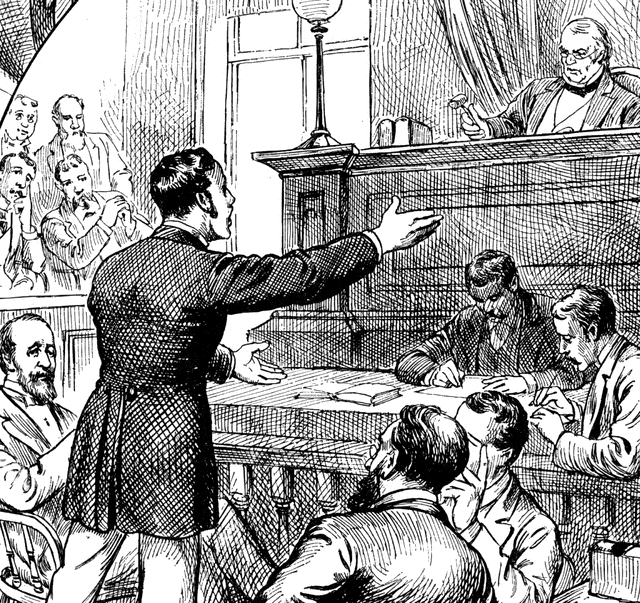Lavinia’s 1st jury trial: “The Courthouse was full of men and women and great excitement prevailed.”
In the 19th century only men could be jurors. So when Lavinia Goodell strode into the Jefferson County Courthouse on September 17, 1874, to try her first jury case she faced a male judge, a male opposing counsel, an all-male jury and . . . a courtroom filled with gawkers. Again, we have her firsthand account of the day.

After Lavinia persuaded a justice of the peace to find two Fort Atkinson saloonkeepers guilty, click here, they immediately appealed to the Jefferson County Circuit Court. This meant she would have to try the cases to 12 male jurors, who might not sympathize with her female clients or their cause: selling liquor on Sundays in violation of an ordinance.
About a month before the trials, her clients reported that the saloonkeepers were pulling out all the stops for their defense:
In p.m. got a letter from Mrs. Powers saying the enemy were making elaborate preparations for defense and had got Carswell [a lawyer.] Am quite stimulated by this intelligence.
On September 11th, Lavinia headed to court for a pre-trial conference. She wrote: “The lawyers and judge not polite and nice to me.” Still, the District Attorney agreed to let her prosecute the cases. The judge said they would be tried “in a week or two,” so she returned home to Janesville.
Surprise! Late on September 15th she was summoned to return to Fort Atkinson for the trials. After working all the next day, she told her diary: “Am awful nervous over them. Heaven help me tomorrow.”
Lavinia rose the next day at 3:00 a.m., headed to the depot in the pitch dark accompanied by her father, who carried a lantern so they could see. She “packed off in a freight train” in Janesville in order to reach Fort Atkinson (22 miles away) in time for court. Imagine Wisconsin’s first woman lawyer in her Sunday best with a satchel of legal papers, seated on a crate in a freight train racing to her first jury trial before dawn!
Drama ensued the instant Lavinia stepped off the train. In a letter to her sister, she described how her adversaries tried to ambush her prosecution:
When the train reached Fort Atkinson, my temperance women came to tell me that the suits had been put off, and none of them were going up. I said there must be some mistake about it, as the judge had notified me to come at that time, and the witnesses had been subpoenaed, and we had better go.
Sure enough, it turned out to be a trick of the enemy, to throw us off the track, by circulating the report of a postponement, and so carry their points. Just as the cars were starting, on came the saloon men, with their lawyer and witnesses. They looked quite taken aback when they saw us women.
I was so amused, I could hardly contain myself. The lawyer was a man I knew but he would not look at me for a good while. When at last I caught his eye he bowed, and I spoke up very pleasantly, “Good morning Mr. R___ this is an unexpected pleasure!” He was about the maddest man you ever saw, and I ready to explode with fun. Well! When we got there and Court opened our witnesses had not arrived.
I told the judge a report had been circulating that our suits were postponed, and by it our witnesses had been detained. Mr. R___ immediately popped up to say he hadn’t circulated any such story.
Well! Our witnesses soon came, and we proceeded to trial. There were two lawyers on the other side, and a third helping in the background – all experienced. The District Attorney helped me some, but he was a young lager beer Dutchman, and no great help.
The Courthouse was full of men and women and great excitement prevailed. I was considerably scared, but not so much as Mr. R.___. He was so flustered and nervous and “mad,” that it tickled me immensely, and quite put me at my ease.
The first case took nearly all day, and when the verdict of “guilty” came in, you may well imagine I was glad.
That night Lavinia told her diary of the “large turnout of men and women” to watch the trial. She considered the defense “worthy.” She was not satisfied with her speaking but was quite happy with the verdict. It was “lots of fun,” she wrote.
The very next morning, she tried her second case. “Exciting debate on points of law,” she wrote. “Jury not returned with verdict when I came home. Returned in pouring rain . . . Am dying to know result of suit.” On September 19th, she telegraphed for information and “learned that my second suit was lost. Am real sorry but can’t help it. Glad I got one at any rate.”
She may have lost the battle, but she won the war. In late October Lavinia attended a temperance convention in Milwaukee where she ran into her clients, Mrs. Powers and Mrs. Manning. They told her that on the second case the jury was out 6 hours. The jurors:
. . . stood nine to three for a verdict of “guilty,” the three being strong liquor men, the nine finally yielded to them rather than stay out all night. And the saloonkeeper was so discouraged that he gave up his business, so you see it was a moral victory after all.
Note: We don’t know when a woman lawyer first tried and won a jury case in America. Most early women lawyers avoided the courtroom. Lemma Barkeloo reportedly tried a case in 1870, but there are no details about it. Belva Lockwood was trying cases in 1873 and 1874, but again we don’t whether they were court trial or jury trials. If Lavinia was not the first woman to win a jury trial, she was darn close. If you have information on this subject, please post a comment or contact us. CB
Sources consulted: Lavinia Goodell’s Diaries, August 26, September 10-October 22, 1874; Maria Goodell Frost, Life of Lavinia Goodell (unpublished biography); Jill Norgren, Belva Lockwood: The Woman Who would Be President (New York: New York University Press 2007).







